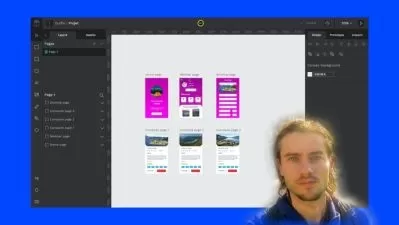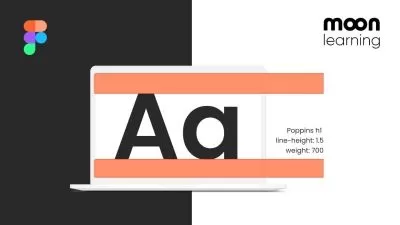Inclusive UX Writing: Gender, Race & Age
Dr. Katharina Grimm
3:21:35
Description
Writing For A Diverse Audience – Part 2
What You'll Learn?
- Know what discrimination regarding sex, gender and sexual orientation
- Know different forms of sexism and gender discrimination
- Understand the reasons and effects of sexism in the tech and UX industry
- Know what sexist UX design and UX copy look like
- Know how to write gender-inclusive UX copy
- Know what racism and racialization are
- Understand the reasons and effects of racism in the tech and UX industry
- Know what racist UX design and UX copy look like
- Know how to write anti-racist UX copy
- Know what ageism is, especially ageism against older adults
- Understand the reasons and effects of ageism in the tech and UX industry
- Know what ageist UX design and UX copy look like
- Know how to write inclusive UX copy for older adult users
Who is this for?
What You Need to Know?
More details
DescriptionOur ethnicity, our gender, our age – all of these aspects are part of our identity. They shape who we are, how we think – and how we experience digital products. This is especially true for the way digital products communicate with us, so for example, if we feel included by the way a question is phrased, or if we feel insulted by a certain metaphor and allusion. And this is exactly why learning about inclusion is crucial for UX Writers. After all, it is our job to create great user experiences for all users, no matter their background and traits.
However, we are still not there: Today, many digital products still lack inclusion, especially in their copy: The use of racial slurs, subtle sexism and ageist vocabulary is still widespread is still common.
But:
What are the effects of sexism, racism, and ageism in the tech and UX industry?
What do sexist, racist, and ageist UX design and UX copy look like?
How can we ensure that our UX copy is inclusive of users of all backgrounds and demographics?
If you ask yourself these and other questions and have not yet found an answer to them, this course is the right choice for you!
This course is the second part of a short series about inclusive UX Writing.
This course will is about how to write gender-inclusive, anti-racist, and age-inclusive UX copy.
The first one is about how to write inclusive UX copy for users with physical disabilities and neurodivergent users.
Who should join
This course is a great choice for all UX Writers and for people who work with UX Writing, including UX and UI designers, developers, product owners, and project managers. It could be helpful to know what UX Writing is and what it is used for, so if you are a complete beginner, you may think about first checking out my introductory course here on Udemy.
What you will learn
In the first section of this class, you will learn
what discrimination regarding sex, gender, and sexual orientation is
about different forms of sexism
about sexism and gender discrimination in the tech and UX industry
what discriminatory UX design and UX copy look like
how to write gender-inclusive UX copy
In the second section of this class, you will learn
what racism and racialization are
about racism in the tech and UX industry
what racist UX design and UX copy look like
how to ensure anti-racist communication in our UX Writing
In the third section of this class, you will learn
what ageism and age-based discrimination are
about ageism in the tech and UX industry
what ageist UX design and UX copy look like
how to ensure age-inclusive communication in our UX Writing
Sounds good? Then join this class and learn how to write inclusive UX copy!
Who this course is for:
- UX Writers
- Content Designers and Content Strategists
- Everybody who wants to transition into UX Writing
- Copywriters, journalists, and other professionals who are working on transitioning into UX Writing but would love to learn more about UX Writing
- Designers, developers, and project managers who want to integrate UX Writing into their team
- Everybody who is interested in this topic!
Our ethnicity, our gender, our age – all of these aspects are part of our identity. They shape who we are, how we think – and how we experience digital products. This is especially true for the way digital products communicate with us, so for example, if we feel included by the way a question is phrased, or if we feel insulted by a certain metaphor and allusion. And this is exactly why learning about inclusion is crucial for UX Writers. After all, it is our job to create great user experiences for all users, no matter their background and traits.
However, we are still not there: Today, many digital products still lack inclusion, especially in their copy: The use of racial slurs, subtle sexism and ageist vocabulary is still widespread is still common.
But:
What are the effects of sexism, racism, and ageism in the tech and UX industry?
What do sexist, racist, and ageist UX design and UX copy look like?
How can we ensure that our UX copy is inclusive of users of all backgrounds and demographics?
If you ask yourself these and other questions and have not yet found an answer to them, this course is the right choice for you!
This course is the second part of a short series about inclusive UX Writing.
This course will is about how to write gender-inclusive, anti-racist, and age-inclusive UX copy.
The first one is about how to write inclusive UX copy for users with physical disabilities and neurodivergent users.
Who should join
This course is a great choice for all UX Writers and for people who work with UX Writing, including UX and UI designers, developers, product owners, and project managers. It could be helpful to know what UX Writing is and what it is used for, so if you are a complete beginner, you may think about first checking out my introductory course here on Udemy.
What you will learn
In the first section of this class, you will learn
what discrimination regarding sex, gender, and sexual orientation is
about different forms of sexism
about sexism and gender discrimination in the tech and UX industry
what discriminatory UX design and UX copy look like
how to write gender-inclusive UX copy
In the second section of this class, you will learn
what racism and racialization are
about racism in the tech and UX industry
what racist UX design and UX copy look like
how to ensure anti-racist communication in our UX Writing
In the third section of this class, you will learn
what ageism and age-based discrimination are
about ageism in the tech and UX industry
what ageist UX design and UX copy look like
how to ensure age-inclusive communication in our UX Writing
Sounds good? Then join this class and learn how to write inclusive UX copy!
Who this course is for:
- UX Writers
- Content Designers and Content Strategists
- Everybody who wants to transition into UX Writing
- Copywriters, journalists, and other professionals who are working on transitioning into UX Writing but would love to learn more about UX Writing
- Designers, developers, and project managers who want to integrate UX Writing into their team
- Everybody who is interested in this topic!
User Reviews
Rating
Dr. Katharina Grimm
Instructor's Courses
Udemy
View courses Udemy- language english
- Training sessions 21
- duration 3:21:35
- English subtitles has
- Release Date 2022/11/17

















